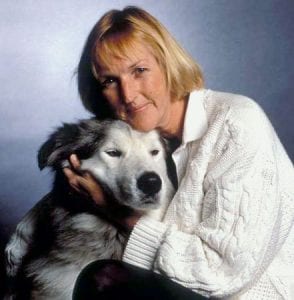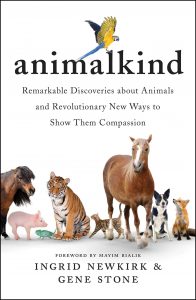Reviewed by Jeffrey Sanzel
Animalkind is subtitled “Remarkable Discoveries about Animals and Revolutionary New Ways to Show Them Compassion.” This succinctly explains this straight-forward work coauthored by Ingrid Newkirk, founder of PETA (People for the Ethical Treatment of Animals), and Gene Stone, who has done extensive plant-based writing.
The book is divided into two parts. The first half deals with understanding animals as beings who “move, chat, love, and romp … and how we humans can benefit from our greater understanding of what makes animals tick.”

Section I covers a wide, diverse range of beings from the wonder of worker ants; to Rico, the extraordinary retrieving Border Collie; to “Clever Hans,” the Orlov trotter who was purported to comprehend sentences and solve math problems (but was revealed to be taking cues from his master). These and many more are analyzed alongside organisms as unusual as maze-solving slime mold:
The dog who jumps for joy when you come home. The emperor penguin guarding his child through a subzero blizzard. The dolphin smiling at us from the water. The sleeping cat’s purr of contentment. The manta ray’s intricate underwater ballets. The lark’s exquisite song. Animals delight, fascinate, and enrich human lives and thoughts every day of the year.
Newkirk and Stone carefully base their arguments in science and not solely issues of feelings and morality. Extensive research, siting multiple sources, are the foundation of their thesis. They make the distinction that we cannot compare animals’ minds and emotions to our own; anthropomorphizing is a dead-end in the understanding of animal natures. This is also true in comparing animals to other animals.
Contrary to common thought, animals — even fish — can be self-aware, and, therefore, experience pain and trauma as well as other emotions. There are detailed discussions of homing instincts and complex migrations in everything from snails to elephants. They look at the long-term effects of removing animals from their natural habitats. Quoting Darwin, animals experience “anxiety, grief, dejection, despair, joy love, ‘tender feelings,’ devotion, ill-temper, sulkiness, determination, hatred, anger, disdain, contempt, disgust, guilt, pride, helplessness, patience, surprise, astonishment, fear, horror, shame, shyness, and modesty.”
In a mix of investigation and anecdotes, the writers paint a vivid picture of a world that more than just co-exists with ours.
Section II deals with difficult issues. It focuses on how animals have been exploited for science, clothing, entertainment, and food. Part two alternates between detailed and often graphic accounts, offering a variety of proposed alternatives. Each of these ends with suggested calls to action.
The science portion gives a brutal narrative of the history of experimentation and vivisection. It discusses the problems with what few laws there are and their poor enforcement. It brings up the 3Rs of humane animal research: replacement (substitutions); reduction (using the fewest number possible); and refinement (techniques that reduce the pain and stress).
 According to their sources, much of the testing on animals is of limited-to-no value given the dissimilarities of humans and animals. In addition, computer simulations are slowly replacing many areas of exploration: “In the future, the math may replace the mouse.” Finally, they encourage people to only use products and brands that are proven to be cruelty-free.
According to their sources, much of the testing on animals is of limited-to-no value given the dissimilarities of humans and animals. In addition, computer simulations are slowly replacing many areas of exploration: “In the future, the math may replace the mouse.” Finally, they encourage people to only use products and brands that are proven to be cruelty-free.
The ensuing sections follow much the same format: A history of the use of animals, followed by analysis of their abuse, and finally specific changes that people can make in their lives. Everything from the pain of sheep raised for wool to the horrors found in circuses, zoos, and all forms of captivity are recounted. Even the “No Animals Were Harmed in the Making of This Film” is, at best, a half-truth, if not a lie. “Free range,” “free roaming,” and “cage-free” are often misnomers, misrepresenting the reality.
Dunkirk and Stone also provide a brief but informative history of the animal protection movement. This segues into the health benefits of a plant-based diet, describing the various meat, dairy, and egg alternatives and echoes the earlier proposals for clothing options that do not involve the harming or slaughter of animals.
The book is passionate and honest in its goals; it makes its points with clarity and sincerity. Ultimately, people are reluctant to make changes they see as inconvenient and the advocacy here is large one. Whether this book creates converts to the cause remains to be seen. However, for those who do read it, it will certainly make a lasting impression.
Animalkind is available at Book Revue in Huntington, Barnes & Noble and online through Simon & Schuster (simonandschuster.com) and Amazon.





